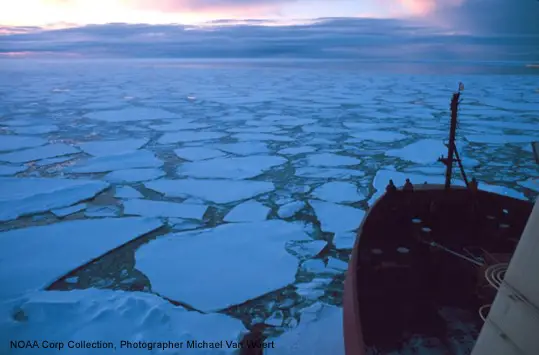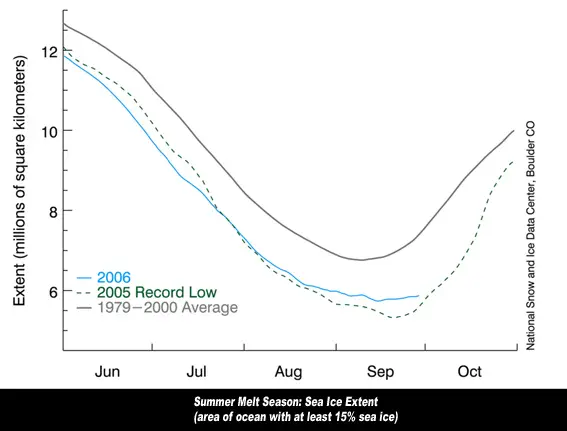Sea ice is formed from ocean water that freezes. Because the oceans are salty, this occurs at about minus 1.8 °C (28.76°F). Frozen sea water is in contrast to icebergs, which are chunks of ice shelves or glaciers that calve into the ocean. Icebergs are compacted snow and hence fresh water. In the Arctic, this persists year after year, whereas almost all Southern Ocean or Antarctic is “seasonal ice,” meaning it melts away and reforms annually. Both the Arctic and Antarctic are of vital importance to the marine mammals and birds for which they are habitats, and play a crucial role in regulating climate.

Sea ice covers about 11% of the ocean, depending on the season. It affects albedo, salinity, and ocean-atmosphere thermal exchange. The latter determines the intensity of convection in the ocean and, consequently, the mean time scale of deep-ocean processes affecting CO2 uptake and storage. Projected changes in climate will produce large reductions in the extent, thickness, and duration of these frozen areas. Major areas that are now ice-bound throughout the year are likely to have lengthy periods during which waters are open and navigable.
Observations in the northern hemisphere already have shown a significant decrease in spring and summer extent by about 10-15% since the 1950s. In 2005 a new record low was set for the Arctic. The thickness has likewise shown substantial decline in recent decades. Using data from submarine cruises, scientists have determined that the mean ice draft at the end of the melt season in the Arctic has decreased by about 1.3 meters over the past 30 to 40 years.

The National Snow and Ice Data Center (NSIDC) lead scientist Ted Scambos says, “Arctic sea ice is an important climate indicator because it’s so sensitive to this initial warming trend.” As it melts in response to rising temperatures, it creates a positive feedback loop: melting ice means more of the dark ocean is exposed, allowing it to absorb more of the sun’s energy, further increasing air temperatures,ocean temperatures, and ice melt. The observed changes in the cover indicate that this feedback is now starting to take hold. This is only one indicator of Arctic change amongst many. Other changes taking place are permafrost melt, changing patterns of vegetation from tundra to shrubs, a warming ocean, and accelerated melt of the Greenland ice sheet.
Given the especially steep decline of fozen waters since 2002 and the record low in September 2005, scientists at NSIDC have been closely monitoring conditions. It also has been suggested that the decline in volume is underestimated because of significant thinning of sea ice in the Arctic. Evidence from whaling records implies a decline in Antarctic ice extent by as much as 25% between the mid-1950s and the early 1970s. A marked warming trend is evident in the Antarctic Peninsula, with spectacular loss of ice shelves, and movement of glaciers which must cause a rethink of the stability of the larger West Anatarctic Ice Sheet.
